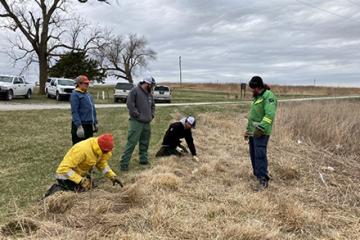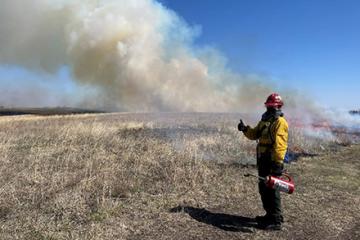Burning Better

Devan McGranahan instructs a group of students on how to conduct pre-burn fuels data collection. (Photo courtesy of Carissa Wonkka)
As wildfires and toxic smoke pour across North America, millions of people are experiencing the harm that fire can cause. But fire can also be an ally in protecting natural landscapes, when it is deployed in the right ways. That’s why ARS researchers recently led a workshop designed to meld the insights of science with the day-to-day operations of fire management, for professionals who use the practice known as prescribed burning.
One of the oldest and most effective techniques for native ecosystem management, prescribed burning involves setting planned fires under carefully selected conditions (optimal wind speeds, relative humidity, etc.). Such conditions allow managers to match fire behavior to project objectives. As they burn, the fires clear out materials like dry plant matter that prevents vigorous plant regrowth. The burns also stimulate a variety of beneficial natural processes in ecosystems that have evolved with and are adapted to periodic fires.
“Prescribed fire is really an important tool for maintaining ecosystem health, resilience to drought, controlling pest species, maintaining biodiversity, wildlife habitat – even things like water quality can be impacted by a lack of fire and a buildup of brush,” said Carissa Wonkka, a research ecologist at the ARS Pest Management Unit in Sidney, MT. Wonkka was one two ARS scientists leading the workshop project, along with Devan McGranahan, a research ecologist at the Livestock and Range Research Laboratory in Miles City, MT.
While prescribed burning has proven helpful since Indigenous people began practicing it centuries ago, some challenges remain. In particular, researchers found a lack of communication between front-line fire managers who set prescribed fires and scientists who look at data to determine which practices work best. That gap means that it can be difficult for researchers to understand how their findings are being applied, and at the same time, difficult for land and fire managers to assess how prescribed burns are meeting their objectives.

A student ignites a line on the instructional burn. (Photo courtesy of Chris Woodson, USFWS)
To bridge that divide, ARS researchers partnered with The Nature Conservancy and Tallgrass Prairies and Oak Savannas Fire Science Consortium to host the workshop. According to Wonkka, the workshop served as “a novel opportunity to enhance wildland fire literacy by introducing early career land managers and graduate students to the integration of fire science and operations technique.”
“Problems are not always ecological in nature,” said Wonkka. “We live in complex social-ecological systems where nature isn’t separate from humans. We know a lot of the ecological and management answers. But there are social dynamics that preclude adoption or slow adoption. If we have the best management practices but no one’s willing to use them, what use are they?”
The practices that the team is teaching represent a significant shift after decades of land management devoted to suppressing fire, an approach that ultimately made wildfires larger and more destructive. Part of the goal of the current work is to help managers replace those kinds of inherited practices with approaches grounded in up-to-date knowledge. That knowledge includes understanding the importance of attracting grazing animals to recently burned areas to maintain lower grass fuel loads, and of slowing the spread of woody plants like juniper and other shrubs, which are more dangerous fuels than native grasses when burning.
Expanding the reach of those insights by bridging the gap between fire science, ecology, and management helps to ensure that management is tailored to objectives and research achieves its purpose, spreading awareness of the complex dynamics that govern the spread of fires — and of human knowledge. — Kathryn Markham, ARS Office of Communications
You May Also Like:

